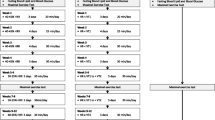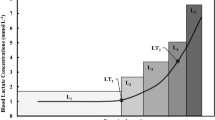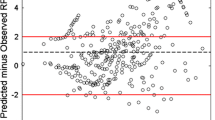Summary
The validity of the relative percent concept for equating training intensity was investigated using the point of metabolic acidosis (anaerobic threshold) as the criterion variable. Percent oxygen uptake, heart rate and metabolic acidosis were determined at 60, 70, and 80% of max heart rate on a bicycle ergometer test (N=31). At 60 and 70% of max heart rate only one individual was definitely in metabolic acidosis. At 80% max heart rate 17 subjects were working at a level above the point of metabolic acidosis while 14 were working at or below this point. Thus, it was suggested that even if subjects are exercising at the same relative percent maximum HR, the metabolic stress using metabolic acidosis as the criterion is not constant across subjects. It was further shown that the regression of percent \(\dot V\)O2 max on percent max HR was a spurious one resulting in poor prediction of individual \(\dot V\)O2 values. The data presented suggest that the relative percent concept for equating exercise or subsequent training intensity needs careful re-evaluation.
Similar content being viewed by others
References
Burke, E. J., Franks, D. B.: Changes in \(\dot V\)O2 max resulting from bicycle training at different intensities holding total mechanical work constant. Res. Quart. Amer. Ass. Hlth. Phys. Educ. 46, 31–37 (1975)
Crews, T. R., Roberts, J. A.: Effects of interaction of frequency and intensity of training. Res. Quart. Amer. Ass. Hlth. Phys. Educ. 47, 48–55 (1976)
Damato, A. N.: Hemodynamic response to treadmill exercise in normal subjects. J. Appl. Physiol. 21, 959–966 (1966)
Davis, J. A., Vodak, P., Wilmore, J. H., Vodak, J., Kurtz, P.: Anaerobic threshold and maximal oxygen uptake for three modes of exercise. J. Appl. Physiol. 41, 544–550 (1976)
Davies, C. T. M., Knibbs, A. V.: The training stimulus: The effects of intensity, duration and frequency on max aerobic power output. Int. Z. Angew. Physiol. 29, 299–304 (1971)
Durnin, J. V. G.: Effects of a short period of training of varying severity in some measurements of physical fitness. J. Appl. Physiol. 15, 161–165 (1960)
Faria, I. E.: Cardiovascular response to exercise as influenced by training of various intensities. Res. Quart. Amer. Ass. Hlth. Phys. Educ. 46, 31–37 (1975)
Fox, E. L., Mathews, T. K.: Intensity and distance of interval training programs and changes in aerobic power. Med. Sci. Sports 5, 18–22 (1973)
Fox, E. L., Mathews, T. K.: Frequency and duration of interval training programs and changes in aerobic power. J. Appl. Physiol. 38, 481–484 (1975)
Gaesser, G., Brooks, G.: Muscular efficiency during steady-state exercise: Effects of speed and work rate. J. Appl. Physiol. 38, 1132–1139 (1975)
Girandola, R. N., Katch, F. I., Henry, F. M.: Prediction of oxygen intake from ventilation, and oxygen intake and work capacity from heart rate during heavy exercise. Res. Quart. Amer. Ass. Hlth. Phys. Educ. 42, 362–373 (1971)
Haslam, R. W., Stull, G. A.: Duration and frequency of training as determinants of coronary tree capacity in the rat. Res. Quart. Amer. Ass. Hlth. Phys. Educ. 45, 178–184 (1974)
Hellerstein, H. K., Hirsch, E. L., Ader, R., Greenblot, N., Siegel, M.: Principles of exercise prescription. In: Exercise testing and exercise training in coronary heart disease (J. P. Naughton, H. K. Hellerstein, eds.), pp. 129–169. New York: Academic Press 1973
Holloszy, J.: Biochemical adaptations to exercise: Aerobic metabolism. In: Exercise and sport science reviews (J. H. Wilmore, ed.). New York: Academic Press 1973
Jackson, J. H.: Cardiorespiratory adaptations to training at specified frequencies. Res. Quart. Amer. Ass. Hlth. Phys. Educ. 39, 295–300 (1968)
Londeree, B. R., Ames, S. A.: Trend analysis of % \(\dot V\)O2 max-Hr regressions. Med. Sci. Sports 8, 122–125 (1976)
Naimark, A., Wasserman, K., McIlroy, M. B.: Continuous measurement of ventilatory exchange ratio during exercise. J. Appl. Physiol. 19, 644–652 (1964)
Nupp, W. F.: The relative effectiveness of four cardio-respiratory conditioning programs. J. Sport Med. (Torino) 10, 84–89 (1970)
Pollock, M. L.: The quantification of endurance training programs. In: Exercise and sport science reviews (J. A. Wilmore, ed.). New York: Academic Press 1973
Saltin, B., Blonquist, B., Mitchell, J. H., Johnson, R. L., Jr., Wildenthal, K., Chapman, C. B.: Response to submaximal and maximal exercise after bed rest and training. Circulation 38 (Suppl. 7), 19–20, 40–41, 63–69 (1968)
Sharkey, B. J.: Intensity and duration of training and the development of cardio-respiratory endurance. Med. Sci. Sports 2, 197–202 (1970)
Skinner, J. S., Jankowski, L. W.: Individual variability in the relationship between heart rate and oxygen intake. Med. Sci. Sports 6, 68 (1974)
Taylor, H. L., Haskell, W., Fox III, S. M., Blackburn, H.: Exercise tests: A summary of procedures and concepts of stress testing of cardiovascular diagnosis and function evaluation. In: Measurement in electrocardiography (H. Blackburn, ed.), pp. 259–305. Springfield: Thomas 1969
Wasserman, K., Whipp, B., Koyal, S., Beaver, W.: Anaerobic threshold and respiratory gas exchange during exercise. J. Appl. Physiol. 35, 236–243 (1973)
Wenger, J. A., MacNab, R. B. J.: Endurance training: The effects of intensity, duration and initial fitness. J. Sport Med. (Torino) 15, 199–211 (1975)
Wilmore, J. H.: A simplified method for obtaining aliquots of respiratory air. Res. Quart. Amer. Ass. Hlth. Phys. Educ. 39, 324–328 (1968)
Author information
Authors and Affiliations
Rights and permissions
About this article
Cite this article
Katch, V., Weltman, A., Sady, S. et al. Validity of the relative percent concept for equating training intensity. Europ. J. Appl. Physiol. 39, 219–227 (1978). https://doi.org/10.1007/BF00421445
Accepted:
Issue Date:
DOI: https://doi.org/10.1007/BF00421445




